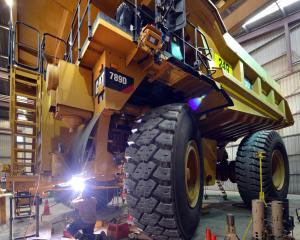The effects of plunging global commodity prices will be high on the agenda of New Zealand's annual mining conference this week, with hundreds of New Zealand jobs shed during the past year and all companies under operational reviews.
For the faint-hearted on the sidelines, some will be questioning whether New Zealand's resource sector is not in crisis.
However, as with other primary industries, such as forestry, lamb and beef and dairying, the respective sectors consolidate in the tough times and ride out their cyclical troughs, albeit at the expense of regional jobs, exploration or research and development.
In total, hundreds of millions of dollars in resource-sector spending has been stripped from New Zealand's economy, or deferred, during the past 18 months.
The 37th conference of the New Zealand branch of the Australian Institute of Mining and Metallurgy has already attracted more than 300 delegates, including from Australia, Canada and the United States, for the three-day event beginning in Nelson today.
Since its election, the Government has held up the resource sector as a cornerstone of economic resurgence, but that claim now appears hollow, given the separate oil and gas sector has gained major concessions compared to the resource sector.
The Government may now have to underpin Solid Energy's future with a $100 million loan, but it has rejected suggestions of a separate $30 million cash injection to keep one of its West Coast mines operational.
Then, to keep Rio Tinto in New Zealand, the Government shelled out $30 million and concessions to keep the Tiwai Point aluminium smelter open, arguably linked more to the pending Meridian Energy float than to the loss of 3000 direct and indirect Southland jobs.
With the sector under siege on several fronts, there are heightened expectations that Energy and Resources Minister Simon Bridges should front up tomorrow, as scheduled, with some positive, tangible support for the mining community.
Previous ill-timed Government announcements on mining around conservation areas and a hurried watering down of proposed tax increases last year have left industry players perplexed over the National-led Government's ability to deliver actual benefits for its ''cornerstone'' economic sector.
Neither the junior minerals explorers nor the country's largest gold and coal producers have been immune to commodity volatility, with gold trading 25% down from last September's high and specialist coking coal down 60% on two years ago.
Global thermal coal prices are so depressed the state-owned Huntly power station is importing Indonesian coal, while neighbouring supplier and state-owned enterprise Solid Energy has slashed its Huntly workforce more than 60% during the past year - about 150 jobs. About 700 jobs at indebted Solid Energy are gone across the country.
Oceana Gold's entire operations remain under review, with mine mothballing and 260 West Coast jobs jeopardised, while Bathurst Resources is still extricating itself from legal wrangles delaying its start-up by almost two years.
The North Island's Newmont Waihi Gold has let go contractors as work is completed but has so far managed to retain staffing levels, with two new underground mines, Trios and Correnso, in the pipeline after the closure of their predecessor, Favona.
While the China boom created insatiable demand for iron ore, gold and coking coal, those record commodity prices hid escalating production costs that have been laid bare only now that prices have plunged.
During the conference, operational and technical updates are scheduled from companies including Oceana Gold, L&M Group, Bathurst Resources, Glass Earth Gold, MOD Resources, Chatham Rock Phosphate and lobby group Straterra.
There will be presentations from numerous government agencies and the universities of Otago, Auckland, Waikato and Canterbury.




